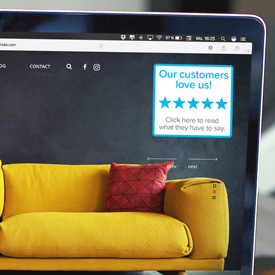The payment services you offer your customers at checkout could be the difference between securing a sale or having them abandon their carts at the last moment. But which options are right for your business? Read on for a breakdown of the leading e-commerce payment services to make your conversion rate soar.
If you’re an e-commerce seller, there’s an important statistic you should know: online shoppers are 70% more likely to finalize a purchase if their preferred payment method is displayed as an option at checkout1.
That’s a significant number. By the time your customers have reached the payment stage on your e-commerce site, you’ve already done much of the hard work of engaging them with your brand. Yet, if you’re not offering an adequate selection of payment options, you risk losing a vast number of them at the final moment – i.e. the dreaded cart abandonment.
To secure the most sales, you need to ensure your site has capabilities to support those payment methods which are most popular with online consumers. Of course, there are the obvious ones – think credit cards and Paypal – but global spending via “Buy Now Pay Later” services is expected to quadruple between 2021 and 20262.
Add in the fact that international customers’ preferences for payment methods vary from country to country, and it can suddenly seem a little overwhelming knowing which ones to incorporate into your e-commerce checkout. Luckily, we’ve done the research for you…read on for a breakdown of all you need to know about e-commerce payment options.
The Best Payment Methods For E-commerce
1. Credit Cards
As an e-commerce merchant, you should be offering your customers payment by credit card as standard. Globally, credit cards are the second most popular payment method, preferred by over 22% of consumers3 – although their popularity is beginning to wane as more shoppers switch to digital wallets and Buy Now Pay Later options.
As credit cards are regulated by compliance standards, they offer both the buyer and seller reassurance that their transactions are secure. Many shoppers are also incentivized to spend on credit cards to have access to their bank’s reward programs.
Tip: Stripe for Credit Cards
Stripe4 is one of the market leaders for processing online merchants’ credit card transactions. It’s a fast and easy-to-implement payment method, and offers competitive rates for small businesses. The platform also has a wide range of additional features including a customer interface toolkit, financial reporting, and buy buttons for mobile apps.
2. Digital / Mobile Wallets
Digital and mobile wallets (also known as eWallets) are forecast to account for over 53% of global e-commerce payment transactions by 2025, making it the most popular online payment method worldwide5.
Digital wallets act like a prepaid credit account, storing the customer’s personal data and funds. It's quick and easy; they are redirected from the e-commerce site’s checkout to the digital wallet’s page where they can simply log in with their existing username and password to complete the purchase. This is particularly handy for those shopping on mobile, where a smaller screen can make the prospect of filling in multiple details particularly unappealing.
6 Digital Wallets To Boost Your Conversion Rate
If you're selling to customers on social media, Metapay15 should be on your radar. This dedicated wallet lets customers pay for products on Instagram, Facebook, WhatsApp and Messenger using stored payment details.
3. Buy Now Pay Later Options
Buy Now Pay Later (BNPL) services are becoming increasingly popular with online shoppers, so if you’re looking to increase your conversion rate, they're worth considering.
With global inflation and the cost-of-living crisis impacting consumers, it’s no wonder paying in installments is an attractive prospect right now. A recent survey16 found that this year, four in ten consumers plan to pay for their holiday shopping with a BNPL service. Gen Z will be the biggest users (48% of respondents), followed by millennials (47%) and Gen X (40%). In contrast, only 14% of baby boomers intend to pay this way.
The three most frequently cited reasons for using BNPL services are: 1) To avoid paying credit card interest; 2) To make purchases that otherwise wouldn't fit in my budget; and 3) To borrow money without a credit check17.
In general, this is all good news for e-commerce merchants. BNPL incentivizes customers to buy, boosts conversion rates, and increases average basket sizes by 20–30%18. It will also drive up your customer lifetime value – once your customers know you offer a BNPL option, they’ll come back to you for their next big-ticket purchase.
Beware though, there are some downsides – namely, you’ll have to hand over a percentage of sales generated. You’ll need to do some cost scenarios to find out if the benefits to your business are likely to outweigh the fees.
Let’s look at a few of the BNPL options out there:
4. Cash On Delivery
As the name suggests, cash on delivery is a transaction where the recipient makes payment for goods at the time of delivery. It may seem an unusual concept to consumers in the West, but in a large part of the world it’s still an everyday process.
In fact, the “cash” part has evolved to include other forms of payment. Some of the leading online marketplaces have capabilities to support digital payment on delivery options. Amazon, for example, offers Pay on Delivery for all items that are Fulfilled by Amazon. A delivery agent will take a package to the customer’s door, and then wait whilst the customer either completes an SMS pay link-based payment using their credit or debit card, or hands over cash.
There are signs this payment method is on its way out though. By 2024, cash on delivery is forecast to be responsible for just 1.7% of total global e-commerce purchases (down from 3.3% in 2020)22. As digital infrastructure in developing markets improves, online shoppers there are becoming more comfortable with paying at the time of purchase via credit cards or digital wallets. The pandemic and subsequent hygiene concerns have also nudged the exchanging of physical money out of favor. Still, in certain markets such as India, Latin America, and some parts of Africa, there is still demand, so do your research.
E-commerce Payment Processing: Three Takeaways
The more options, the better. Offer your customers a wide choice of payment methods at checkout and they’ll be more likely to complete the purchase.
Customize for international customers. Do your research to find out the most popular payment method in the market you’re selling to. And don’t forget to ensure your e-commerce website defaults to the local currency when displaying prices.
Keep it simple. “Guest checkout” and autofill will keep the checkout process quick and pain-free for customers.
E-commerce Payment Methods: FAQs
What are e-commerce payment methods?
E-commerce payment methods enable online shoppers to pay an e-tailer for goods or services. They include digital/mobile wallets, credit or charge cards, debit cards and bank transfers. The seller uses a payment method platform which allows them to accept some or all of these payment methods – ideally, as many as possible so the customer can choose the one that suits them.
What is the best payment method platform for e-commerce?
There isn’t a single best payment method platform for e-commerce. There are so many, with different features and benefits, that you really need to research which is most suitable for your particular business. Shopify, Stax, Stripe, 2Checkout and Square could all be worth thinking about, but there are many others to consider too.
What is the most popular online payment service?
Currently, the most popular online payment service is the digital wallet, PayPal. However, there are many newer wallet services set up to eventually challenge PayPal, such as Apple Pay. Buy Now Pay Later installment payment services, such as Klarna, are also gaining rapidly in popularity.
1 - 2Checkout blog, June 2020
2 - EuroNews, December 2021
3 - Statista, November 2020
4 - Stripe
5 - Statista, November 2020
6 - PayPal
7 - Statista, February 2021
8 - PAYMNTS.com, May 2018
9 - Amazon Pay
10 - Shift 4 Shop blog, March 2018
11 - Apple Pay
12 - Google Pay
13 - Alipay
14 - Tech Wire Asia, August 2022
15 - Meta Pay
15b - TechTarget, June 2022
16 - Bluedot survey, Retail Dive, October 2022
17 - The Ascent survey, Forbes, November 2020
18 - CNBC, September 2021
19 - Klarna
20 - Klarna quote, Big Commerce, Accessed February 2021
21 - Clearpay
22 - Statista, November 2020










